Mat with an elephant and a horse. Triangles deletan

Amateurs when matting with an elephant and horse usually try TWIX.
Severe pros, who are interested in hardcore, act according to Deletan's recipe.
TWIX Method
The “twix” method discussed in a previous article has a long history. Francois Filidor , the same Frenchman who laid the foundations of a modern understanding of chess, came to the horse’s maneuver in the form of the letter W in the 18th century . Over the next century and a half, various authors of chess monographs paid a certain attention to the mat with an elephant and a horse, but this scattered knowledge did not constitute a holistic technique. At the beginning of the 20th century, the Polish grandmaster David Pshepürka systematized all the available information and since then this technique has survived unchanged to our days. In almost any book that pays attention to this ending, this method is described.
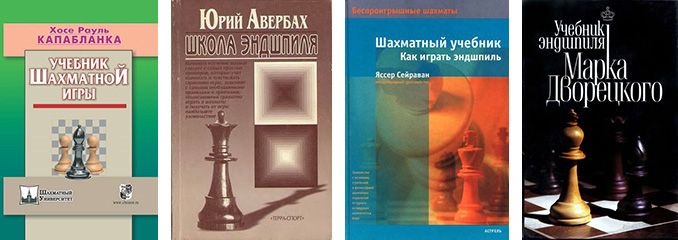
A century later, the children's chess coach Yar Sanych (in the world, Yaroslav Aleksandrovich Prizant) introduced the successful name TWIX so that the children would learn this mat with more pleasure. A well-known pedagogical device - children learn better new material if it is associated with something fun, pleasant, familiar.
Knowledge of the TWIX method allows, by and large, not to bother much with the ousting of the mated king to the corner. It is enough to just step on and, limiting the free space, drive it into any, and if necessary, transfer it along the edge of the board to exactly the one you need. “Twix” is well suited for blitz: the name of the method is mnemonic and allows you to quickly remember what its essence is, even if the player has not trained in this mat for a long time (first, we build all the figures with the letter T, on the strongest side, the horse moves along the W- trajectory, the king moves parallel to the edge of the board in the form of a capital vowel I , and the elephant, if not standing on the edge, always controls two crossed diagonals in the form of the letter X ).

Click on the picture to go to the TWIX method analysis article.
This allows you to checkmate without bothering with detailed calculations and to some extent allows for some inaccuracy in implementation - in which case, if you notice in time, you can quickly fix the consequences of a careless move.
However, if you want something more fundamental, more serious, then you can master it in terms of overall development ...
Deletan Triangles Method
The strongest side does not allow the opponent to hide in a safe corner, but immediately directs him into the matte corner with precise moves.
The first hints of this method date back to 1780, a little later than the time when Philidor spoke in his book about the zigzag movements of the horse. The February issue of the French chess magazine La Stratégie of 1923 published an article entitled "Mat with an elephant and a horse" written by Daniel Deletan , a Frenchman living in Argentina. The article provided an exhaustive analysis of the ending.
The method has not received much distribution, for the following reasons:
- It requires a more accurate calculation than the Twix method. This is especially true for maneuvers with an elephant and a horse - you need to weigh each move, otherwise the king will get out of the matte web and have to start all over again.
- The opponent has a good chance of immediately diving into a safe corner. From him, just in the course of the party, the cursed king may be too close, and the enemy figures are too far away. The strongest side simply does not have time to build the right structure. Then, by and large, there is no need to talk about the application of the method.
- Longer than Twix. Yes, it’s not only easier, but also faster to drive into a safe corner, and then drive to a matte corner, than to drive immediately into a matte corner with accurate maneuvers.
- There is no time for implementation. In pool / blitz / rapid, in fast-paced chess, just in time trouble - there is no particular time to count. But the TWIX method allows you to checkmate on hanging flags with lightning speed, without much going into the details of the position.
- There are no forces for implementation. In a serious tournament game at such a late stage (deep endgame), perhaps there is time for analysis - if the time control is passed. However, after the previous many hours of struggle, the parties can come to this position in a state of physical and moral exhaustion.
The likelihood of getting an ensemble with a knight and an elephant is extremely small in itself. If such a thing does happen, the chances that it will be applied not the Twix method, but the Deletan method, will turn into nothing at all. I don’t know the games, although in the game with the computer you can freely run around the equipment in order to make sure that it works effectively.
A reasonable question: why then learn the method at all? In principle, no one forces anyone. But if you master the Deletan method, then:
rightly feel like an expert on secret chess techniques,
you will understand the game more finely and deeply , you will
finally understand the principles of the interaction of the elephant and the horse, you will
feel the amazing geometry of the board , and you will
play truly academic chess .
Main stages
For simplicity, we assume that the strongest side is white, their elephant is white-field. White drives the black king into the upper left corner. Of course, the alignment in colors and angles can be any other, however, in order not to confuse the explanations, we will dwell on this option.

The matted king is held within three rectangular triangles nested within each other. We will name them as external, middle and small triangles. The common right angle is in the field of the same color along which the elephant walks.
From larger triangles there is a pushing into smaller ones. First, the king from the outer triangle is transferred to the middle (this is the most difficult stage), then from the middle to the small (after which the checkmate is put).
To keep the opponent inside the triangle, it is necessary to control the black-and-white cells in the area of the hypotenuse of the figure. Half of these fields are controlled by an elephant, almost all the rest are usually a horse, and the king left if necessary.
Of this trinity, almost all activity lies with the king, who is almost alone and is engaged in pushing back. The horse and elephant for most of the action are motionless in their positions, putting an insurmountable barrier before the opponent, while being in complete safety.

These three diagrams show from left to right how White fully controls the outer, middle, and small triangles, respectively.
Safety angle clipping
Before you build any triangles, you need to make sure that the mated king does not dive into one of two safe angles (these are angles whose color is opposite to the color controlled by the elephant). Sometimes it is required to find a literally etude solution in order to block this opportunity for the weakest side.
It is not always possible to do this on time and if the lone king managed to temporarily slip away, then you still have to smoke from a safe corner using the TWIX method.
Outer triangle

This is the widest triangle, and you have to use the elephant and the horse and the king to control the hypotenuse.
The task of the elephant and the horse is to control its plots and, at the first opportunity, rebuild by moving from the outer to the middle triangle of Deletan.
The king’s task is to control his area and push the enemy into a dull corner.
The diagram shows the so-called ideal arrangement of the elephant and horse. In principle, these figures can stand differently and at the same time also put an insurmountable wall in front of the enemy king. However, if the horse and the elephant are too far apart, then the task of pushing into a corner becomes quite difficult.
Safety islands
If the elephant and the horse are unsuccessful, then for the black king there may appear areas on the edge of the board where he will feel calm.
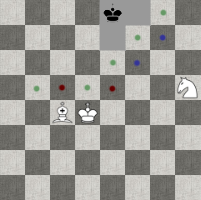 | The diagram shows the situation when White managed to build an external triangle, but it is not obvious how to go to the middle. The elephant and the horse created an insurmountable barrier, but the black king simply stays in three fields marked with a different gray color. While the horse is busy protecting black fields from this side, it is impossible to oust the black king from his "island of security". |
 | To solve the problem, you need to transfer the king to the black squares on the right and shift their guard to him. And send the horse in two jumps to guard the black fields on the left flank. In this configuration, white can already push the black king towards the matte corner. |
 | Black can head towards the bishop and the knight in order to crank out the same trick - to dig in on the new "island of security" near light pieces. While the black king is on his way, White manages to transfer the bishop to the adjacent diagonal and move to the middle triangle of Deletan. |
 | In the middle triangle, driving a lone king into a dull corner is much easier. |
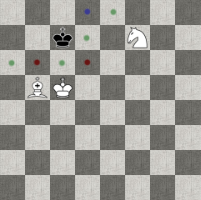 | If the king tries to escape through the right flank, the horse will block the long exits in two jumps. |
Perfect parking
A horse / bishop can have a very different mutual arrangement when they control almost the entire hypotenuse. In this case, the horse is placed on the field of the same color as the elephant. In this way, a group of fields of both colors is jointly controlled. The king takes over the fields outside their area of effect.

However, for the outer and middle triangles there are so-called ideal parking lots. Here they are:

The ideal parking is remarkable in that it allows you to quickly (with just one move of the elephant) transform the outer triangle into a medium (or medium to small) one as soon as possible.
Middle triangle

The hypotenuse is noticeably less and, in principle, for complete control over it, only an elephant and a horse are enough (provided that they are in ideal parking lots ).
The White King is entrusted, mainly, with the task of repression. If the elephant and the horse are not standing perfectly , then they should be regrouped, while their leader covers up the temporary gaps that arose during this.
The black king no longer has any hope for "islands of security" - there is too little space. White without the slightest hassle is forced into a corner, reducing the size of the triangle to a minimum. Everything happens much easier than in the case of an external triangle.
Small triangle
 The hypotenuse is so small that it is easily controlled only by the elephant and king, without the participation of a horse.
The hypotenuse is so small that it is easily controlled only by the elephant and king, without the participation of a horse. The horse performs the final move in order to approach from the right side and finally finally checkmate.
Mat
A certain accuracy is required in this matter, so that inadvertently there is no stalemate.
When the king is securely locked in the corner, then he can be mated with any of a possible pair of dozens of ways. If the ending is played in Deletingan style, then one of two options is obtained by itself:
- A horse with a check drives the king into a corner - he mates an elephant.
- The elephant with the shah drives the king out of the corner - he mates the horse.
For example, if a situation arose like in the diagram above, the scenario depends on whose move is now:
White's move: 1. Nf6-d7 + Kb8-a8 2. Ca6-b7 ×.
Black's move: 1. ... Kb8-a8 2. Ca6-b7 + Kra8-b8 3. Kf6-d7 ×.
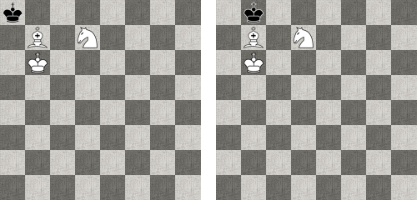
Final algorithm
Taking into account all of the above, we can summarize the optimal order of actions, allowing you to checkmate with an elephant and a horse using the Deletan triangles method.
- Cutting off a lone king from a safe corner. Such an opportunity is not always available if the cursed king is much closer to a safe corner than the figures of the strongest side.
- Construction of the outer triangle of Deletan. If isolation from the saving corner is successful, the strongest side builds the first version of the outer triangle as quickly as possible in order to enclose the opponent in the desired range of the board.
- Transfer of a horse and an elephant to ideal positions in the outer triangle of Deletan. Most likely, the positions of the elephant and the horse will not be the best, so these two figures regroup in the right way. The process insures the king, which controls the cells through which the matted king could break out of the triangle.
- Pushing the lone king from the hypotenuse of the outer triangle to the edge. The horse and the elephant are standing in their ideal parking lots, and their monarch boldly goes towards his opponent.
- The transition from the outer triangle to the middle. When the cursed king moved away from the center, the elephant gets the opportunity to change the diagonal.
- Transfer of a horse and an elephant to ideal positions in the middle triangle of Deletan. And again, you need to transfer the horse and elephant to ideal positions. During the transition period, the king monitors the hypotenuse cells, from which control is temporarily removed.
- Pushing the lone king into a matte corner. A horse and an elephant from their ideal positions hold the perimeter, their king advances, taking away space from his counterpart.
- Transition from the middle triangle to the small one. After the matted king is in the corner, the elephant moves to a new diagonal.
- Matting. The elephant and the king do not allow the weakest side to get out of the corner, a horse is brought for the mat.
We will go the other way
Do not think that chocolate and Deletan methods are all possibilities to checkmate with an elephant and a horse. Sometimes chess knights in torment and suffering give birth to their own path in order to push the naked king into the matte corner.
L. Lyuboevich - U. Polgar , blind match, Monte Carlo, 1994.
The Hungarian very confidently led the king to the desired angle in the style of Deletan (although the similarity is not observed at all stages). This makes it all the more impressive, taking into account the fact that the players did not use the board and simply called each other's moves - the battle went on purely in the minds of the opponents.

D. Harika - Tan Zhongyi , Women's Chess World Championship Semifinals, Tehran, 2017
The Indian chess player once learned the basics, but forgot the details. While her coach backstage feverishly drank carvalol, Harika took time, made dozens of aimless moves, and unsuccessfully recalled what needs to be done. Still, I remembered the letter T, smoked an opponent from a safe corner, and even began a W-trajectory for the horse. But then something went wrong, she almost released the king from the nets, but somehow drove into a corner (and then had to improvise) and mated with grief in half. Before the “rule of 50” there were only a couple of moves left, the Chinese team was already ready to appeal for a draw.
E. Gufeld - S. Palatnik , Tbilisi Championship, 1973.
The party was accompanied by scandalous antics of expressive Gufeld and ended not only with obscenities, but also
This rare translation method, vaguely reminiscent of TWIX, is discussed in a separate article .

Click on the image to go to the article with a detailed description of the cyclic method “Prisoner of the Caucasus”.
Online training
The author of the chess simulator GlukKazan added the ability to specify the location of the pieces directly in the link, which allows you to give positions for training where White manages to build the external Deletan triangle. Click on any of the charts if you want to practice. In the upper left corner on the board there is a button to cancel previous moves. So, if you missed the flight of the black king from triangles, you can rewind the game.

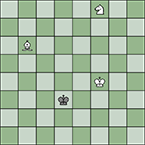



Help to encode any position in the link
The first digit is the type of piece:
0 - Pawn
1 - Rook
2 - Horse
3 - Elephant
4 - Queen
5 - King
After the figure the address of the cell in the usual chess notation is indicated. Letters must be lowercase. After specifying the figures, figures and coordinates, a semicolon follows.
After a hyphen, black pieces are listed in the link. A hyphen is specified only once.
There is no check for the correctness of the link, in this case there will simply be a runtime error.
0 - Pawn
1 - Rook
2 - Horse
3 - Elephant
4 - Queen
5 - King
After the figure the address of the cell in the usual chess notation is indicated. Letters must be lowercase. After specifying the figures, figures and coordinates, a semicolon follows.
After a hyphen, black pieces are listed in the link. A hyphen is specified only once.
There is no check for the correctness of the link, in this case there will simply be a runtime error.
